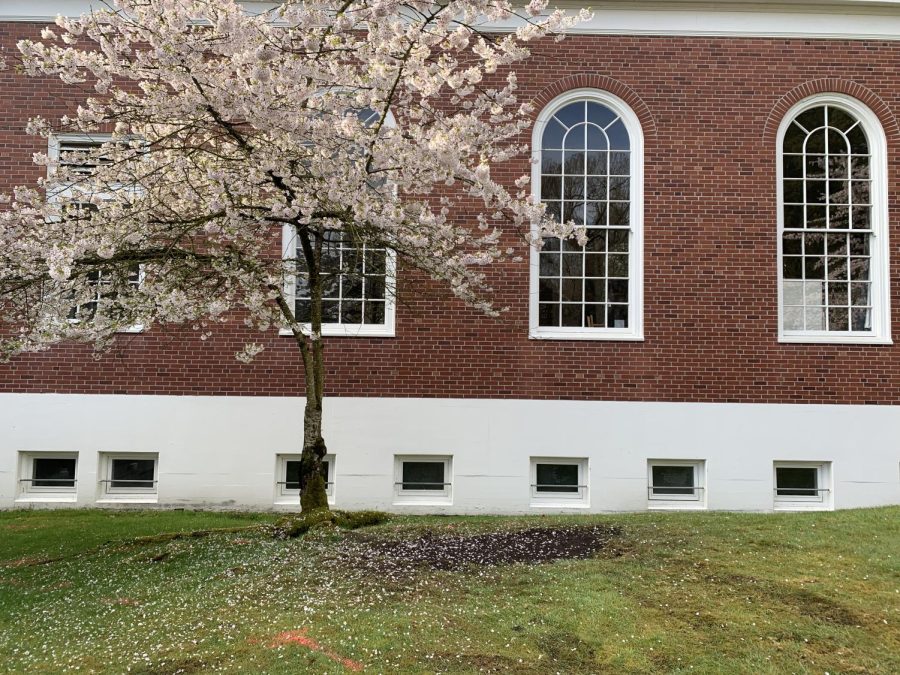The End of the End of an Era
For over 50 years, students walking in the area near the Pigott Family Arts Center or the McKay Chapel passed by the infamous tombstone marking Lakeside’s transition to a co-ed school. Then, after spring break of this year, this suddenly stopped.
“I come back, and the tombstone has literally disappeared. It vanished,” one Lakesider told me.
Although it may have seemed to some students returning from their spring break adventures that the tombstone had more or less walked away, the process of removing the tombstone spanned more than the few days it took maintenance to uplift it. Over the years, many articles have been written critiquing the tombstone, explaining the history of Lakeside’s inevitable transition to co-ed, the implications of the tombstone’s inscription — “in memory of the passing of the last all male senior class” — and the confusion that some students expressed for why Lakeside chose to display this particular piece of history.
Thus, its removal was a deliberate one, a decision that took into account both the intent and impact of the tombstone. Bruce Bailey ’59, who has been a part of the Lakeside community for over 70 years and was the recipient of the 2022-2023 Distinguished Alumni Award, confirmed that the decision to move into a co-ed school, while not supported unanimously, was received well. This was at a time where the saying “better dead than co-ed” was popular at other secondary schools.
Regardless, the tombstone’s modern impact does not match the intent that Mr. Bailey described. It was the acknowledgment of this fact that Mr. Bailey pointed to as evidence of Lakeside’s greatest strength: “Schools should evolve to meet the needs of students at a particular time in their life. So I think [Lakeside has] done a great job of that.”
However, where the discrepancy lies is in the fact that the entirety of the school didn’t vote on whether to remove the tombstone. Instead, the decision was left in the hands of an elective class, Activism and Resistance. The class of seniors drafted a proposal to remove the tombstone, which was then brought to Dr. Bynum and Mr. Boccuzzi. As much as light has been shined on the tombstone in recent years, students outside the class were left entirely in the dark about its removal.
In conversations after spring break, many students thought that an assembly should have been held to inform them, and perhaps a school-wide vote could have been taken. This would have ensured that all grade levels were represented in the decision. Instead, students returned from spring break to sparrows pecking at the ground where a 700-pound tombstone once sat.
Having been in discussions with the class of 1971, who gifted the tombstone as their senior gift to Lakeside in the first place, Mr. Bailey hopes that the tombstone will be returned to a member of the original class. Members of the ’71 class would then be provided the opportunity to reunite around the tombstone for a “full circle” moment since their donation over 50 years ago.
Regardless, Mr. Bailey is adamant that “it can’t stay where it is,” stored behind the WCC. It’s a decision he has pointed to as “totally inappropriate,” noting in our conversation, “I don’t want to lay it in there. I don’t want it to go to the dump.”
As for the current space, Mr. Bailey believes that the cherry blossom tree, which stands only a few feet away from the tombstone, should be involved. I had been under the impression that the tree was there to showcase yet another facet of Washington’s natural beauty, but it was Mr. Bailey who was the first to inform me of its significance.
“[It] was the next fall, when we had a big school celebration, and then the tree was planted so that it was a kind of passing of the torch. The tombstone to the cherry [blossom] tree. One is done. The other one is growing. And that was kind of the metaphor,” Mr. Bailey explained. It is worth noting that the fall the cherry tree was planted was the same fall Lakeside became coeducational.
What happens to the tombstone will ultimately be decided by the administration. Until they decide, the 700-pound tombstone remains half-buried under a pile of mulch behind the WCC, a relic of Lakeside’s history lost among other relics.
Reagan’s Starting Inventory
x1 classic New York attitude
x1 semi-intact California tan
x1 pair of wired headphones for TV Girl and...

